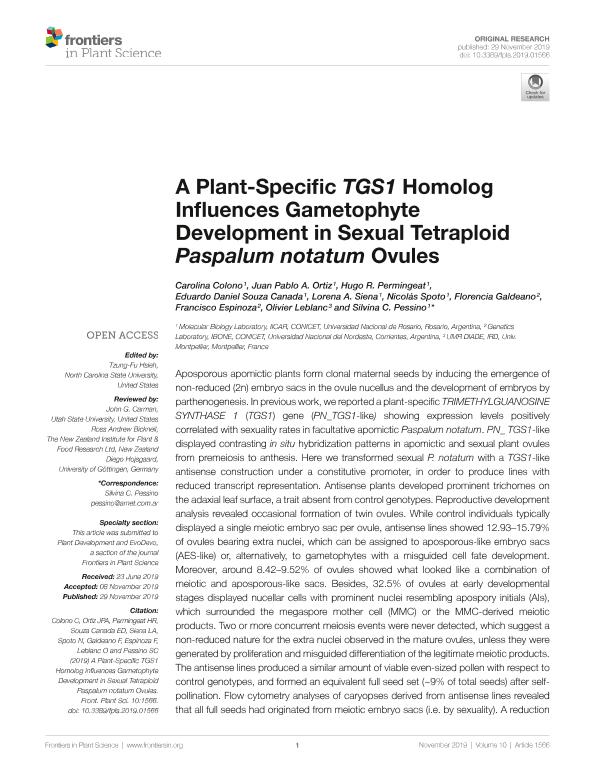Artículo
A plant-specific TGS1 homolog influences gametophyte development in sexual tetraploid Paspalum notatum ovules
Colono, Carolina Marta ; Ortiz, Juan Pablo Amelio
; Ortiz, Juan Pablo Amelio ; Permingeat, Hugo Raúl; Souza Canada, Eduardo Daniel; Siena, Lorena Adelina
; Permingeat, Hugo Raúl; Souza Canada, Eduardo Daniel; Siena, Lorena Adelina ; Spoto, Nicolás Leandro
; Spoto, Nicolás Leandro ; Galdeano, Florencia
; Galdeano, Florencia ; Espinoza, Francisco
; Espinoza, Francisco ; Leblanc, Olivier; Pessino, Silvina Claudia
; Leblanc, Olivier; Pessino, Silvina Claudia
 ; Ortiz, Juan Pablo Amelio
; Ortiz, Juan Pablo Amelio ; Permingeat, Hugo Raúl; Souza Canada, Eduardo Daniel; Siena, Lorena Adelina
; Permingeat, Hugo Raúl; Souza Canada, Eduardo Daniel; Siena, Lorena Adelina ; Spoto, Nicolás Leandro
; Spoto, Nicolás Leandro ; Galdeano, Florencia
; Galdeano, Florencia ; Espinoza, Francisco
; Espinoza, Francisco ; Leblanc, Olivier; Pessino, Silvina Claudia
; Leblanc, Olivier; Pessino, Silvina Claudia
Fecha de publicación:
11/2019
Editorial:
Frontiers Media
Revista:
Frontiers in Plant Science
ISSN:
1664-462X
Idioma:
Inglés
Tipo de recurso:
Artículo publicado
Clasificación temática:
Resumen
Aposporous apomictic plants form clonal maternal seeds by inducing the emergence of non-reduced (2n) embryo sacs in the ovulenucellus and the development of embryos by parthenogenesis. In previous work, we reported a plant-specific TRIMETHYLGUANOSINESYNTHASE 1 (TGS1) gene (PN_TGS1-like) showing expression levels positively correlated with sexuality rates in facultative apomicticPaspalum notatum. PN_ TGS1-like displayed contrasting in situ hybridization patterns in apomictic and sexual plant ovules frompremeiosis to anthesis. Here we transformed sexual Paspalum notatum with a TGS1-like antisense construction under aconstitutive promoter, in order to produce lines with reduced transcript representation. Antisense plants developed prominenttrichomes on the adaxial leaf surface, a trait absent from control genotypes. Reproductive development analysis revealedoccasional formation of twin ovules. While control individuals typically displayed a single meiotic embryo sac per ovule, antisenselines showed 12.93-15.79% of ovules bearing extra nuclei, which can be assigned to aposporous-like embryo sacs (AES-like) or,alternatively, to gametophytes with a misguided cell fate development. Moreover, around 8.42-9.52% of ovules showed what lookedlike a combination of meiotic and aposporous-like sacs. Besides, 32.5% of ovules at early developmental stages displayed nucellarcells with prominent nuclei resembling apospory initials (AIs), which surrounded the megaspore mother cell (MMC) or theMMC-derived meiotic products. Two or more concurrent meiosis events were never detected, which suggest a non-reduced naturefor the extra nuclei observed in the mature ovules, unless they were generated by proliferation and misguided differentiation ofthe legitimate meiotic products. The antisense lines produced a similar amount of viable even-sized pollen with respect to controlgenotypes, and formed an equivalent full seed set (~9% of total seeds) after self-pollination. Flow cytometry analyses of caryopsesderived from antisense lines revealed that all full seeds had originated from meiotic embryo sacs (i.e. by sexuality). A reduction of25.55 % in the germination percentage was detected when comparing antisense lines with controls. Our results indicate that PN_TGS1-like influences ovule, gametophyte and possibly embryo development.
Palabras clave:
APOMIXIS
,
APOSPORY
,
METHYLTRANSFERASE
,
PLANT REPRODUCTION
,
TGS1
Archivos asociados
Licencia
Identificadores
Colecciones
Articulos(IBONE)
Articulos de INST.DE BOTANICA DEL NORDESTE (I)
Articulos de INST.DE BOTANICA DEL NORDESTE (I)
Articulos(IICAR)
Articulos de INST. DE INVESTIGACIONES EN CIENCIAS AGRARIAS DE ROSARIO
Articulos de INST. DE INVESTIGACIONES EN CIENCIAS AGRARIAS DE ROSARIO
Citación
Colono, Carolina Marta; Ortiz, Juan Pablo Amelio; Permingeat, Hugo Raúl; Souza Canada, Eduardo Daniel; Siena, Lorena Adelina; et al.; A plant-specific TGS1 homolog influences gametophyte development in sexual tetraploid Paspalum notatum ovules; Frontiers Media; Frontiers in Plant Science; 10; 11-2019; 1-14
Compartir
Altmétricas



